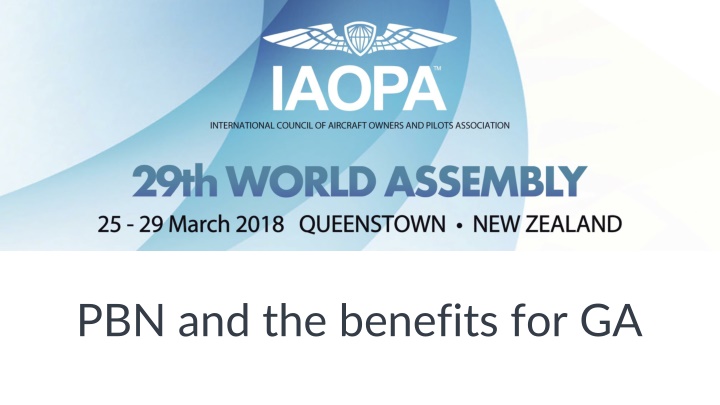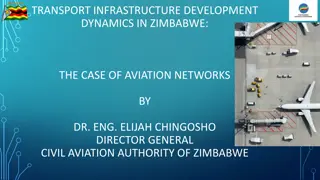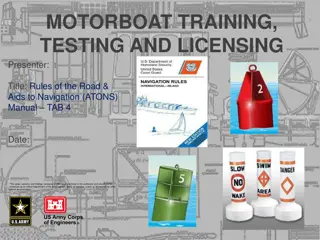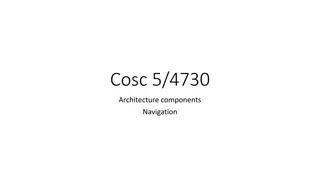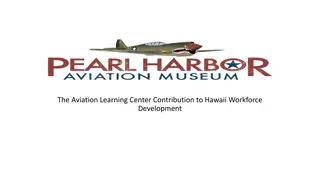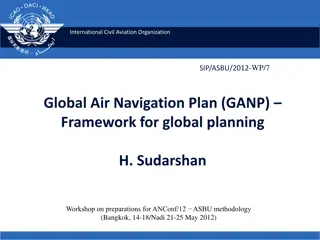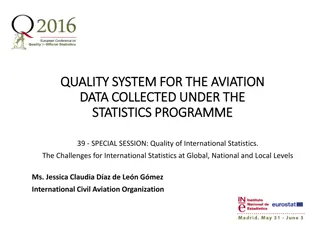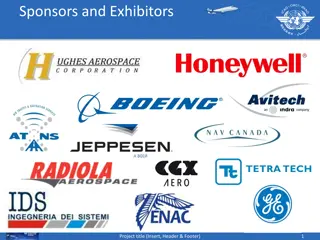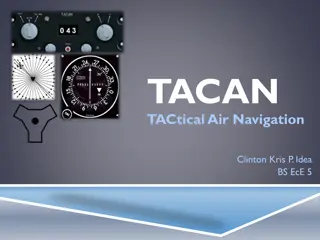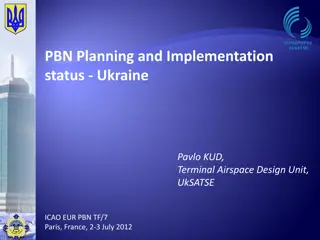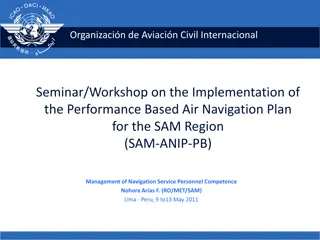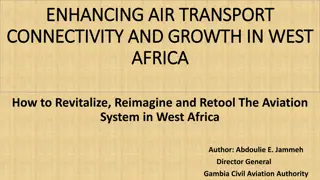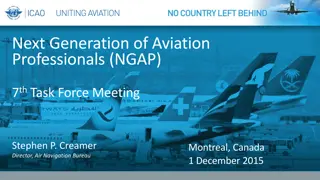Performance Based Navigation (PBN) Benefits for General Aviation
Performance Based Navigation (PBN) offers significant benefits for General Aviation, enhancing operational efficiency, route options, and airspace capacity. Through RNAV and RNP specifications, PBN provides improved on-board alerting and monitoring, potentially reducing reliance on ground-based navaids. Key considerations for General Aviation include avionics requirements, pilot training, and operational approvals, leading to increased airspace capacity and route structure enhancements. PBN also enables specialist operations and offers a technology-neutral, satellite-navigation-friendly approach, standardizing procedures internationally.
Download Presentation

Please find below an Image/Link to download the presentation.
The content on the website is provided AS IS for your information and personal use only. It may not be sold, licensed, or shared on other websites without obtaining consent from the author.If you encounter any issues during the download, it is possible that the publisher has removed the file from their server.
You are allowed to download the files provided on this website for personal or commercial use, subject to the condition that they are used lawfully. All files are the property of their respective owners.
The content on the website is provided AS IS for your information and personal use only. It may not be sold, licensed, or shared on other websites without obtaining consent from the author.
E N D
Presentation Transcript
I A O P A 2 9t h W o r l d A s s e m b l y Performance Based Navigation (PBN) and the Benefits for General Aviation Our Speakers: Steve Smyth Director, New Southern Sky, Air Transport and Airworthiness Civil Aviation Authority of New Zealand Mark Adeane Navigation Procedure Designer Aeropath Ltd / Airways New Zealand Graham Cheal Manager Aircraft Operations, Airline Technical Support Air New Zealand Moderator: Andrew Andersen (Australia)
I A O P A 2 9t h W o r l d A s s e m b l y (quick recap of the essentials!) Performance Based Navigation Two kinds of specifications: RNAV (aRea NAVigation) RNP (Required Navigation Performance) What s the fundamental difference between RNAV and RNP? On-board alerting and monitoring. => a more robust version of RNAV => additional routes, greater capacity.
I A O P A 2 9t h W o r l d A s s e m b l y Performance Based Navigation Potential Benefits: Why do this? Cautions for GA: Avionics requirements: Many IFR GA are TSO C129a equipped CDI scaling differs between TSO C129a and TSO C146 Issues with SIDs and STARs in some countries Ground-based navaid rationalisation Pilot instrument ratings, training and transition arrangements Operational approvals. Increased capacity, especially for airlines and major airports: Can be good for GA too, with equitable airspace policies Could even allow more airspace for VFR, depending on policy Achievable transition pathway from RNAV Depends on sensible policies for avionics standards and requirements Could facilitate route structure improvements Remove dependency on ground-based navaids, reduced distances Specialist ops advantages (for example, RNP 0.3 low helicopter routes) Calculation of lowest safe altitudes Technology neutral But satellite-navigation-friendly (better than terrestrial route structures) Contains and integrates APV (LNAV/VNAV, LPV) Standardised procedures internationally.
I A O P A 2 9t h W o r l d A s s e m b l y Performance Based Navigation (PBN) and the Benefits for General Aviation Steve Smyth Director, New Southern Sky, Air Transport and Airworthiness Civil Aviation Authority of New Zealand
I A O P A 2 9t h W o r l d A s s e m b l y Performance Based Navigation (PBN) and the Benefits for General Aviation Mark Adeane Navigation Procedure Designer Aeropath Ltd / Airways New Zealand
I A O P A 2 9t h W o r l d A s s e m b l y Performance Based Navigation (PBN) and the Benefits for General Aviation Graham Cheal Manager Aircraft Operations, Airline Technical Support Air New Zealand
I A O P A 2 9t h W o r l d A s s e m b l y Performance Based Navigation Panel and Audience Questions and Discussion Points Most GA IFR pilots will never fly AR approaches, but they have, or will soon be, converting from terrestrial and previous RNAV specifications. What are the key points for IFR GA pilots to consider as they make the transition?
I A O P A 2 9t h W o r l d A s s e m b l y Performance Based Navigation Panel and Audience Questions and Discussion Points Most GA IFR pilots will never fly AR approaches, but they have, or will soon be, converting from terrestrial and previous RNAV specifications. What are the key points for IFR GA pilots to consider as they make the transition? What can GA pilots learn from the transition made by airline crews to new navigation technology?
I A O P A 2 9t h W o r l d A s s e m b l y Performance Based Navigation Panel and Audience Questions and Discussion Points Most GA IFR pilots will never fly AR approaches, but they have, or will soon be, converting from terrestrial and previous RNAV specifications. What are the key points for IFR GA pilots to consider as they make the transition? What can GA pilots learn from the transition made by airline crews to new navigation technology? New Zealand and Australia are jointly trialling SBAS technology as we speak. What would be the key safety and efficiency benefits for GA, and the aviation industry more generally?
I A O P A 2 9t h W o r l d A s s e m b l y Performance Based Navigation Panel and Audience Questions and Discussion Points Most GA IFR pilots will never fly AR approaches, but they have, or will soon be, converting from terrestrial and previous RNAV specifications. What are the key points for IFR GA pilots to consider as they make the transition? What can GA pilots learn from the transition made by airline crews to new navigation technology? New Zealand and Australia are jointly trialling SBAS technology as we speak. What would be the key safety and efficiency benefits for GA, and the aviation industry more generally? The PBN nav specs are standardising some concepts that were previously disjointed and so there are benefits in procedure design, nomenclature and presentation. How can other forms of standardisation - setting personal weather minimums; choosing quality, standardised training; and adopting custom approach checklists and briefings be used to make IFR approaches more consistently safer and efficient? What can we apply from PBN generally, and RNP Approach (including AR) procedures in particular, to leverage IFR flight safety for GA?
I A O P A 2 9t h W o r l d A s s e m b l y Performance Based Navigation Panel and Audience Questions and Discussion Points Most GA IFR pilots will never fly AR approaches, but they have, or will soon be, converting from terrestrial and previous RNAV specifications. What are the key points for IFR GA pilots to consider as they make the transition? What can GA pilots learn from the transition made by airline crews to new navigation technology? New Zealand and Australia are jointly trialling SBAS technology as we speak. What would be the key safety and efficiency benefits for GA, and the aviation industry more generally? The PBN nav specs are standardising some concepts that were previously disjointed and so there are benefits in procedure design, nomenclature and presentation. How can other forms of standardisation - setting personal weather minimums; choosing quality, standardised training; and adopting custom approach checklists and briefings be used to make IFR approaches more consistently safer and efficient? What can we apply from PBN generally, and RNP Approach (including AR) procedures in particular, to leverage IFR flight safety for GA? As our countries implement PBN, what are the key messages for GA, pertaining to enroute, terminal and approach modes of flight for pilots to consider?
I A O P A 2 9t h W o r l d A s s e m b l y Performance Based Navigation Panel and Audience Questions and Discussion Points Thank you for your participation.
